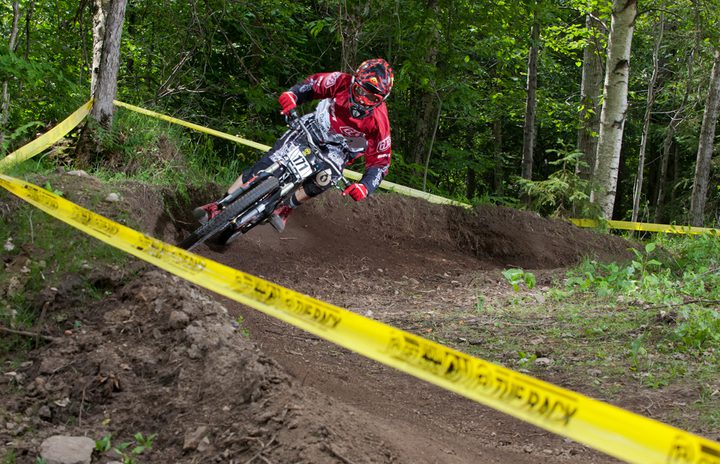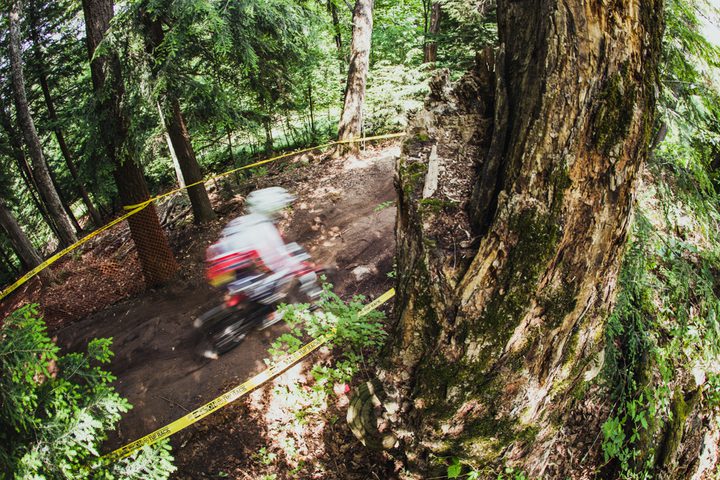Beginners guide to downhill mountain biking
“Every year I meet XC and road riders who try DH for the first time and they are blown away by how physical and mental the riding is."

By Malcolm Howe

I consider myself a cross country rider who loves a variety of trails. My favourite rides are long, technically difficult and scenic. But, I am a chicken: I have a love/hate relationship with speed. Most folks who think of themselves as cyclists have probably never ridden a downhill mountain bike. As someone who has spent much of his life riding bikes, I understand. My advice is simple: you have to try it.
I could detail a long list of skill-based techniques, vacation options and technology for the geeks among us, but simply, DH riding is really fun. I asked a couple of experts what newbies typically said after their first day at the park. Answers included: “I can’t believe how much fun that was and how tired I am,” and “It’s so cool to ride in the summer between the ski trails. What time do you guys open tomorrow?” DH bikes have really slack head-tube angles, which means they don’t endo very easily. They weigh a lot more than most other bikes. Many DH rigs tip the scales at 35 lb. or more. They certainly don’t accelerate up hills, but they are very stable over rough terrain and are incredibly “squishy” when riding over obstacles. Finally, they have powerful brakes and really big tires.
What are the benefits of downhill riding? Many great cyclists have spent time on a variety of bikes. Strong technical riders often have a background in BMX (or even motocross). It is hard to find a XC racer who doesn’t spend a ton of training time on a road bike. Anyone who has ever ridden a pump track, quickly learns how important technique is to being smooth and efficient. Just like with craft beer or ethnic food, trying new stuff is always a worthwhile pursuit.

Brian Finestone from the Whistler Bike Park says, “Every year I meet XC and road riders who try DH for the first time and they are blown away by how physical and mental the riding is. They all assume there is little to no cardio requirement in DH riding and seem surprised that they can get to an aerobic state so quickly. On the skill building side, the concentrated downhill bike handling from one day in a bike park can top weeks of XC experience climbing for short descents. I know seasoned adventure racers who have done DH clinics and improved their race times by becoming more competent and confident riding steep, gnarly terrain.”
“Start off on the easiest trails and get comfortable on the bike,” says Mike Scheur from Whiteface DH Park. “Practise using your brakes without skidding. Just look where you want to go and the less you brake the easier it gets.”

1. Relax. Above all else, DH is about having fun. Most parks have “flow” trails that are a great place to start. Typically, the terrain is a sustained downhill with occasional bermed curves and small jumps. As an expert in going over the handlebars on jumps, I always recommend rolling over (or around) them on the first run.
2. Let the bike do its job. DH bikes are made for sucking up terrain. They are very stable at speed. “Point and shoot” is advice I have heard on numerous occasions. Be sure to lower your seat to keep it out of play. Many DH bikes will be equipped with dropper posts – they are awesome on any bike.
3. Keep your body weight centred. Watch a downhiller on a steep spot. It will look as if he is just standing up on the pedals. Use your arms and legs as additional shock absorbers. Many experts will tell you to “keep your elbows up” to give you optimal control.
4. Go small before you go big. Try hitting a small drop or jump. A good DH bike will absorb even a terrible landing if the drop is small. The key is to power the bike off the jump. A bike that leaves an obstacle fairly level also tends to land fairly level.
5. Look up trail as you ride. You don’t want to focus on small stuff just in front of your wheel. DH is about letting the bike roll and guiding the ship.
6. Resist the urge to brake for no reason. I’m as guilty as anyone here with excessive braking. It really doesn’t help at all. During braking, the bike won’t steer nearly as well. As you approach a scary spot, get the bike pointed the way you like and then let it roll. Too much front brake will cause the bike to slide out on curves. Try not to lock up the rear end and skid around curves as it will create ruts and eventually destroy the trail.
7. Take a lesson. Let instructors show you the ropes. They are there to make sure you have a fun and safe experience. They will also help direct you to the trails that best suit your tastes and skill level. Both Finestone and Scheur strongly suggest hiring a guide. “Once new DH riders are comfortable on their bikes, guides will take them on trails that build their skills at appropriate rates for their skill resumé,” says Finestone. “The fun comes when a rider is relaxed on the bike and lets it do what it does best, tracking through unbelievably rough terrain, jumping and going fast downhill. This formula applies whether the rider comes from road, XC or even BMX race. The more relevant the previous experience, the faster the rider will adapt to the downhill environment. Olympic BMX stars Mike Day and Barry Nobles tried DH for the first time and by their third run were riding the biggest jumps in our park. However, when put on the gnarly technical trails, they had to dial it back to intermediate trails until they could learn the techniques required for that style of riding. By the end of the day, both were hooked and now make annual pilgrimages to ride DH.”

